Goldflame spirea is cultivated not only for its dense panicles of dark pink flowers but also for the changing colors of its foliage.
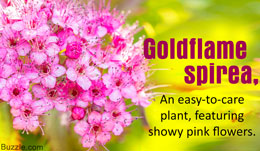
Did You Know?The extreme adaptability of Spiraea japonica is no more considered as a beneficial feature. In the wild, it is difficult to control its spread. In some areas of North America, the long-lasting seeds of this plant are making it difficult to restore native vegetation.The botanical name of goldflame spirea is Spiraea japonica. The plant is naturally variable in form and there exist about 10 varieties of the species. It is native to Japan, China, and Korea. It was introduced in Northern America in around 1870. It is now naturalized there. It is used as an ornamental landscape plant in the U.S. and also in some parts of Canada.
The genus Spiraea consists of about 100 species of shrubs in the family Rosaceae. These shrubs are endemic to the temperate northern hemisphere. A great variety of these shrubs can be seen in Eastern Asia. A number of cultivars have been developed, and depending upon the characteristic features, they are being grown as hedges, low screens, or foundation shrubs. The low-growing forms of Spiraea are used as groundcovers or in borders.
Spiraea japonica 'goldflame' is also known as Spiraea bumalda Burv. and Spiraea japonica var. alpina Maxim. 'Goldmound', 'Candlelight', 'Magic Carpet', 'Dart's Red', 'Golden Princess', 'Nana', 'Little Princess', 'Shibori' or 'peppermint stick', 'Anthony Waterer', 'Neon Flash', etc. are some other popular varieties. With some care, the plant grows well in zone 3. It is hardy in zones 4-8. It is perfect for adding color and flair to the garden. It can also be used for bordering the garden.Plant Profile
1. Size, Shape, and Type
➺ It is a deciduous, perennial shrub. It grows in a 'mounded' form, and attains an oval shape over the ground. It grows to about 1.2 to 2 m in height and width. The brown or reddish brown stems with alternate leaves are erect but wiry. Sometimes, they are hairy.
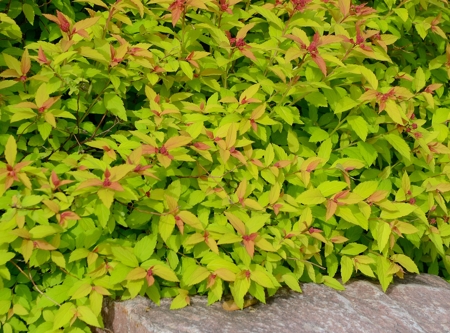
➺ The ovate-shaped small green leaves have toothed margins. They are about 2.5 cm to 7.5 cm long. They emerge orange-red and turn bright yellow as they mature. Then they turn luminous green and again turn deep red in fall.
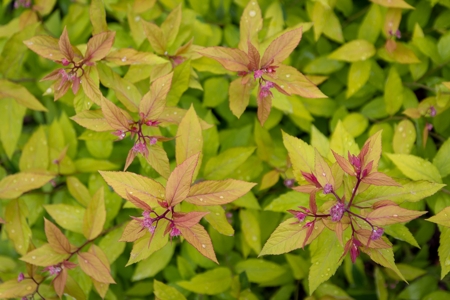
➺ During spring and summer, the branches produce attractive clusters of rosy-pink flowers. During the growing season, if faded flowers are promptly removed, they produce flowers again.
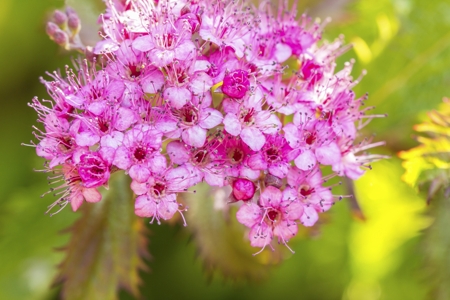
➺ The tiny seeds are about 2.5 mm long and are borne in small lustrous capsules.
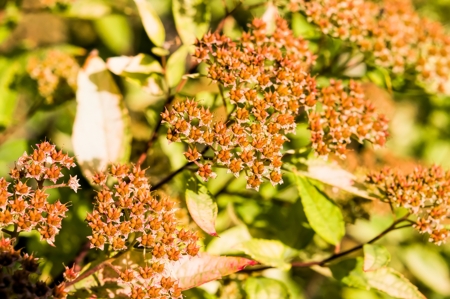 2. Habitat
2. Habitat
The plant grows well in wetland habitats, for example, on the banks of a river or stream. It is found growing wildly along forest edges, old home sites, and roadsides.Care
1. Planting
Planting goldflame spirea in spring or early fall is recommended. Dig a hole larger than that of the container. The plant can grow in a wide variety of soils, including slightly alkaline soils, but it grows well in a rich, moist loam. Prepare a soil mix with some compost or peat moss. Remove all unwanted things like fabric, plastic, wire, etc. Set the root ball properly in the hole. If the roots are tightly packed, rake them apart lightly with your fingers. Back-fill with the amended soil. Build a basin, and water the plant. Add a 2" (5 cm) layer of mulch (shredded bark) around the plant. Keep it at least 4" (10 cm) away from the trunk. Otherwise, extra moisture in it can lead to decaying of the bark.
A highly alkaline soil may cause yellowing of the leaves. In that case, an acid fertilizer can be used. If the soil is poor, you can add compost, peat moss, or good planting soil to it. A slow-acting fertilizer fed in the spring can increase the chances of survival of the plant.
2. Light
The plant can tolerate heat as well as light shade. It grows well in full sun to part shade. Plant it in full sun for best color display.
3. Watering
The plant needs lots of water during the growing season. So water it regularly. However, saturated soils for extended periods of time can lead to root rot. Let the soil dry somewhat between irrigation applications.
4. Pruning
Since these plants bloom on the current season's growth, they should be pruned in late winter once the threat of extreme cold has passed. They can be pruned in early spring too. You may cut them all the way to the ground. Pruning goldflame spirea bushes lightly as the flowers fade can stimulate growth of the branches that can again produce abundant flowers. Mowing can control the spread of the plants, it cannot eradicate them. As new branches would emerge, you will have to cut them again. Pruning helps maintain the shape of the plant.
5. Pest Control
Common pests or diseases can occasionally affect the health of these plants (for example, leaf spots, fireblight, powdery mildew, rots, aphids, leaf roller, etc.), but the problems will be relatively minor. Applying a soap spray is the best way to get rid of aphids. The plant is pretty much resistant to diseases and insects.
6. Fertilization and Mulching
A general-purpose fertilizer can be fed before new growth begins in spring. Spread a 1-inch layer of compost under the shrub every spring. Spread a 2-inch layer of mulch (may contain chopped bark or pine needles) over the compost. Mulch should be spread a few inches away from the trunk of the shrub. The compost increases the nutritional value of the soil, while the mulch helps conserve water. Because of the mulch, the temperature of the soil remains moderate and uniform. Established trees should be fertilized every 2-3 years.
7. Propagation
As a single plant produces hundreds of seeds, these plants reproduce aggressively in the wild. The seeds remain alive in the soil for many years. They are viable and can germinate naturally. Wind, dust, and water promote dispersal and deposition of seeds along stream banks. In home or city gardens, the plants can be propagated with the help of sucker division or softwood cuttings during summers. Hardwood cuttings can also be used for propagation. Such cuttings can be rooted outdoors in the fall. You may plant some branches in pots and may transplant them outdoors afterwards. You may divide the plants in fall.
8. Winter Care
No winter protection is required.
9. Companion Plants
To have a good succession of color in the garden, goldflame spirea plants should be planted with ideal companion plants. For a mixed shrub border, you can plant 'goldflame' with other deciduous shrubs such as forsythia, daphne, and clethra. The dark-foliaged creeping juniper or heuchera can be planted in the background. The dark purple foliage of the Aster lateriflorus can also create a wonderful background for this spirea plant. You can plant it with Loropetalum too.Goldflame spirea shrub is one of the easiest ones to grow and maintain. It requires occasional maintenance and upkeep. It attracts butterflies and adds a charm to your garden. Under ideal conditions, these plants grow quickly and can live for about 20 years. They usually retain a nice shape as they grow. You can plant them singly or in groups. The attractive clusters of flowers and amazing foliage colors make goldflame spirea a real eye-catcher.






 Did You Know?The extreme adaptability of Spiraea japonica is no more considered as a beneficial feature. In the wild, it is difficult to control its spread. In some areas of North America, the long-lasting seeds of this plant are making it difficult to restore native vegetation.The botanical name of goldflame spirea is Spiraea japonica. The plant is naturally variable in form and there exist about 10 varieties of the species. It is native to Japan, China, and Korea. It was introduced in Northern America in around 1870. It is now naturalized there. It is used as an ornamental landscape plant in the U.S. and also in some parts of Canada.
Did You Know?The extreme adaptability of Spiraea japonica is no more considered as a beneficial feature. In the wild, it is difficult to control its spread. In some areas of North America, the long-lasting seeds of this plant are making it difficult to restore native vegetation.The botanical name of goldflame spirea is Spiraea japonica. The plant is naturally variable in form and there exist about 10 varieties of the species. It is native to Japan, China, and Korea. It was introduced in Northern America in around 1870. It is now naturalized there. It is used as an ornamental landscape plant in the U.S. and also in some parts of Canada. ➺ The ovate-shaped small green leaves have toothed margins. They are about 2.5 cm to 7.5 cm long. They emerge orange-red and turn bright yellow as they mature. Then they turn luminous green and again turn deep red in fall.
➺ The ovate-shaped small green leaves have toothed margins. They are about 2.5 cm to 7.5 cm long. They emerge orange-red and turn bright yellow as they mature. Then they turn luminous green and again turn deep red in fall. ➺ During spring and summer, the branches produce attractive clusters of rosy-pink flowers. During the growing season, if faded flowers are promptly removed, they produce flowers again.
➺ During spring and summer, the branches produce attractive clusters of rosy-pink flowers. During the growing season, if faded flowers are promptly removed, they produce flowers again. ➺ The tiny seeds are about 2.5 mm long and are borne in small lustrous capsules.
➺ The tiny seeds are about 2.5 mm long and are borne in small lustrous capsules. 2. Habitat
2. Habitat